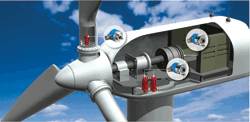Encoder technology is key for wind energy capture
BY TY MACALPINE
Sick-Stegmann
Dayton, OH
http://www.stegmann.com
Rotary encoders play an important role in the wind industry by providing the high resolution feedback necessary to run the very dynamic control systems of today’s turbines. Selecting the correct encoder will greatly enhance the system’s ability to run at optimum power out, and to maximize return on investment.
According to Lawrence Berkeley National Laboratory, in 2008 U.S. wind power capacity surged by 51%, with 8,545 MW added and more than $16 billion invested. 7,800 new off-grid turbines were installed and 1,292 on-grid. The average capacity of a turbine is about 1.7 MW. Wind power capacity was up about 46% in the previous year, 2007.

Fig. 1. As many as five encoders are used in wind turbine control systems.
The cutaway picture (see Fig. 1) of a wind turbine shows one commonly used control system. This type would typically use five encoders, providing feedback to maintain the generator’s performance in various wind conditions, and for various load requirements.
• The blade pitch control system maintains the speed of the rotor as wind conditions change.• The yaw control system (azimuth) controls the rotation of the entire generator based on wind direction.• Generator speed is monitored by tracking the rpm of the generator shaft.
The three types of rotary encoders commonly used with wind turbines are incremental, absolute, and hybrid, with each technology offering advantages and disadvantages. The following overview will help guide the design engineer to the best choices for each part of the system.
Incremental encoders
Incremental rotary encoders are single-turn devices that generate a fixed number of pulses per revolution of the shaft. An advantage of this type of feedback is the instantaneous response to changes in the shaft speed, making it ideal for tracking the rpm of the turbine’s generator. Other advantages are that it is widely available and lower in cost than other types.
Incremental encoders can be used to control the movement of blade pitch and yaw, but with the disadvantage that they do not maintain position data. Verifying and tracking the relative position of the blade and generator would need to be incorporated into the control system design with additional inputs from proximity switches or hall effect sensors for reference points.
Absolute encoders
Absolute rotary encoders are available in single- or multi-turn versions, and resolve shaft position by reading multiple tracks on an optical disc or some type of magnetic pickup system. This type has the capability of maintaining position data, even when the control system is powered down. Multi-turn versions include geared stages for tracking the number of times (into the thousands) the shaft has turned, eliminating the need for batteries to maintain position information. Position data is read directly, rather than incrementally, and is available shortly after the power is applied.
Absolute encoders provide position feedback data via a SSI, Profibus, DeviceNet, or CANopen serial interface. These interfaces can limit the rate at which the feedback position data is sent, so it is not instantaneous. This can prevent the use of absolute encoders for tracking generator speed. However this is not a limiting factor for tracking the slower positioning change of the generator and in some blade pitch control systems.
Hybrid rotary encoders
The hybrid type of encoder is available in single- or multi-turn and offers the advantages of both the incremental and absolute encoder technologies in one unit. This enables users to potentially replace two encoders, reducing costs and space. This type of encoder provides a pulse, or sine/cosine waveform that is ideal for blade pitch control systems because it provides the instantaneous feedback necessary to control a motor with speeds up to 6,000 rpm, while maintaining absolute single- or multi-turn position data when the system is powered down. There are a number of motor drives available today that have incorporated standard inputs to accept feedback with sine/cosine waveforms. In some cases, customers have obtained an increased motor efficiency.

An overview
Not all rotary encoders are created equal, and the optical and magnet technologies used in today’s incremental, absolute and hybrid encoder designs have evolved to increase resolution, temperature range and durability. Optical encoder designs have been improved with new technologies such as the Opto-ASIC, with second or third generation designs that offer higher resolution capabilities, increased operating rpm, and improvements to the operating temperature range. Additionally, Opto-ASICs have added the ability to make the encoder customer-programmable with field adjustable resolution, output driver type (TTL or HTL), and marker width.
The metal optical disc is another key encoder component that has been improved, yieding encoders that can operate in harsh environments with increased resolution. In the past, incremental and absolute encoders required the use of a glass disc to reach higher resolutions, which had the disadvantage of reducing the shock and vibration resistance. The newer metal discs have increased, resolutions by as much as six times without the use of electronic multipliers, with much better shock and vibration specifications.
Many of the newer encoder designs have resulted in a reduction of the size of their enclosures. However, all of the improvements in technology and reduction in size will amount to little if the design and construction do not meet a high standard of quality. For example, the quality of the bearings, how they are mounted, and the separation between the bearings will have a great effect on the life of the encoder. ■
For more information on encoders and transducers, visit http://www2.electronicproducts.com/Sensors-Transducer.aspx
Advertisement
Learn more about SICK





